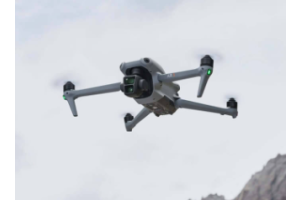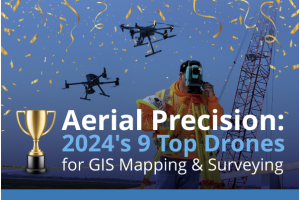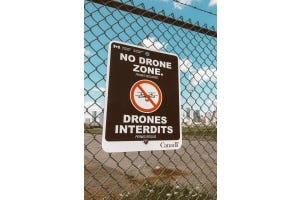As the world of aviation evolves, drones are playing an increasingly significant role. The FAA, recognizing the prevalence of these gadgets, has instituted the Remote ID Rule to ensure the safety and accountability of drone operations. For drone pilots, understanding this rule comes down to two things: adhering to regulations and being part of a more integrated National Airspace System. This guide gives you a comprehensive overview of the FAA's Remote ID Rule and its implications, keeping you informed and ready to navigate this new legal landscape.


What is Remote ID and Why is it Important?
Say you’re driving on the road without license plates on vehicles. It'd be challenging, if not impossible, to keep everyone accountable. Similarly, in the sky, drones need a "digital license plate" to maintain order, and that's where Remote ID comes into play.
Acting as this virtual identification, Remote ID provides real-time information, broadcasting a drone's identification and location to other parties.
Integrating drones into the National Airspace System (NAS) is a massive step in aviation. It lays the groundwork for organized and more complex drone operations in the future.
Moreover, Remote ID isn't just for the FAA's benefit. Law enforcement and other federal agencies also stand to gain. With the ability to swiftly identify and locate drones that may be flying unsafely or in restricted zones, they can respond promptly, protecting the airspace and people below.
Who Needs to Comply?
The FAA's Remote ID rule is broad-reaching, encompassing almost all drones taking to the U.S. airspace. Whether you're capturing wedding or architecture shots for a client, monitoring your crops or livestock out in the open farm, keeping track of your construction project, or merely flying your drone as a weekend hobbyist, compliance is essential.
However, there are a couple of noteworthy exceptions:
- Lightweight Drones for Recreation:
If you own a drone that's under 0.55 pounds, and you only use it for recreational purposes, you're exempt from the Remote ID requirements. But remember, the moment you decide to use that lightweight drone for any commercial task, the exemption no longer applies.
- Exclusive Flights in FAA-Recognized Identification Areas (FRIA):
FRIAs serve as specific zones where the standard Remote ID rules take a backseat. If you commit to flying your drone exclusively within these designated areas, you're free from the Remote ID rule's grip. FRIAs are especially beneficial for those who might not have the means to upgrade their equipment immediately or are flying drones that aren't compliant by design.
Extensions and Deadlines: Key Dates to Remember
While many might have marked their calendars for the original enforcement date, the FAA made an important revision.
On September 13, 2023, just a hair's breadth away from the original deadline, the FAA issued a statement granting drone pilots a grace period up until March 16 next year, to fulfill the broadcast requirement of the Remote ID Rule. This move isn't an extension of the compliance deadline itself, but rather a leniency period for enforcement. While the expectation for pilots to abide by the Remote ID remains unchanged, the FAA understands the challenges some face in achieving this.
The Line in The Sand: March 16, 2024
Past this date, the skies won't be as forgiving. Any non-compliance could translate to considerable fines or even the suspension or revocation of pilot certificates. So, while the FAA's gesture provides some room to maneuver, it's a call to action for every drone pilot to ensure they're on the right side of the regulations.
To put it simply, if your drone's software can be effortlessly updated to comply with the Remote ID rule, you should make the change right away. However, if your drone requires a broadcast module and you're unable to procure one just yet, the FAA's extension provides a breather, allowing you to adapt without immediate repercussions.
Why the Deadline Extension?
There were different reasons behind the FAA’s six-month grace period. These include
- Shortage of Remote ID Broadcast Modules
The most prominent was the unexpected shortage in the supply of Remote ID broadcast modules. These modules are pivotal for drones that aren't inherently compliant with the Remote ID requirements. They essentially act as an add-on, broadcasting vital identification information to fulfill the Remote ID mandates. As the deadline loomed, the demand for these modules surged, leading to major suppliers running out of stock. Recognizing this challenge and the sincere intent of many drone operators to comply, the FAA initiated talks of a possible extension as early as September.
- Delays in Declaration of Compliance Approvals
Another hiccup in the rollout of the Remote ID requirements was the slow pace at which the FAA issued Declaration of Compliance (DOC) approvals to drone manufacturers. A DOC is essentially a drone manufacturer's assertion that their product aligns with the Remote ID requirements. Understandably, consumers prefer drones that have secured their DOC, ensuring that their purchase aligns with FAA mandates. The backlog in approvals, coupled with the looming deadline, created a scenario where potential buyers were left uncertain about their drone purchases.
- Manufacturer Software Update Delays
In addition to hardware challenges, software became another hurdle. Drone manufacturers were expected to release Remote ID-compliant drones and firmware updates for older models by September 16, 2022. Despite these expectations, several manufacturers struggled to release timely updates for all their drone variants. Even industry giants like DJI had a handful of popular models, including the DJI Mavic 2 Pro and DJI Air 2, that hadn't received the necessary firmware updates, leaving owners of these drones in a compliance limbo.
- FRIA Approval Bottlenecks
The FAA introduced the concept of FAA-Recognized Identification Areas (FRIA) as an alternate route to achieve compliance. Drone pilots flying within these zones could operate drones that aren't technically compliant with the Remote ID rule, offering a reprieve from the technology mandates. However, the FAA's pace in approving FRIA applications lagged, with hundreds of applications pending even as the initial deadline neared.
Also Read: Update After March 2024 Deadline Passed
3 Methods to Comply with the Remote ID Rule
How exactly can drone operators ensure they’re compliant? There are 3 distinct methods to meet the Remote ID requirements:
1. Standard Remote ID Drones
These are the latest generation of drones designed with Remote ID capabilities embedded right from the manufacturer. Essentially, these drones come equipped to broadcast critical information throughout their flight. This data includes:
- The drone’s unique, compliant serial number (its digital ID).
- Its real-time location, altitude, and speed.
- The location and elevation of its control station (pilot's position).
- Time-specific marks to ensure data integrity.
- Any emergency status, should one arise.
Drones produced after September 16, 2022, should have built-in Remote ID compliance. For older models, a firmware update might introduce the necessary Remote ID features.
Newer drone models, including the likes of DJI’s Mavic 3 series, Matrice 350 RTK, Avata, Mini 3 and Air 2S, come equipped with built-in Remote ID capabilities. They're also part of the FAA's Declaration of Compliance list, so just a firmware update will activate their Remote ID feature.
2. Remote ID Broadcast Modules
For those who've invested in drones that don't natively support Remote ID, there's no need to fret. The FAA permits the use of Remote ID Broadcast Modules, such as Cube ID. These are attachable devices that retrofit drones to make them compliant. Once attached, the drone will broadcast:
- The drone's unique, compliant serial number.
- Its current location, altitude, and velocity.
- Its takeoff location and elevation.
- Time-specific marks similar to the standard drones. However, a crucial limitation here is the requirement for the operator to maintain a visual line of sight with their drone at all times during flight.
3. FAA-Recognized Identification Areas (FRIA)
For drone enthusiasts or professionals who might not have access to the above solutions, FRIAs provide a sanctioned airspace where drones can operate without broadcasting any Remote ID data. While this offers flexibility, there are specific conditions:
- Drones must always remain within the visual line of sight.
- They must stay strictly within the designated FRIA region.
- While anyone can fly within these zones, only community-based organizations and educational institutions can request the establishment of an FRIA.
Registration Process for Drone Pilots
Recreational vs. Part 107 Pilots: Know The Difference
First off, note that recreational pilots and Part 107 pilots have different registration procedures. While recreational drone enthusiasts can register once, listing multiple devices under a single registration, the Part 107 pilots have a more detailed approach. Each device they operate, be it a Standard Remote ID drone or a Remote ID broadcast module, must be registered individually, receiving a unique registration number.
Guide to Registering Your Drone
The registration process is pretty straightforward:
1. Log into the FAADroneZone.
2. Depending on your status (recreational or Part 107), ensure you're on the right dashboard.
3. Navigate to “Manage Device Inventory” and add your drone or module.
4. Provide the necessary details, including the Remote ID serial number (easily available on the device or its controller).
5. Finalize by saving or adding the device.
Updating Your Registration Details
Over time, if you need to make modifications to your registered information, it's as simple as revisiting your inventory on the FAADroneZone, selecting the specific device, and updating the relevant fields. Always keep your registration details current to avoid any non-compliance issues.
The Future: Session ID
The progression of the Remote ID ecosystem is soon to be augmented with Session ID. This feature will give operators of Standard Remote ID drones the option to either broadcast their conventional drone's ID (which acts as a Remote ID-compliant serial number) or opt for the newer Session ID. But what does this mean for the drone pilot community?
The FAA's Vision for Session ID
The design ensures that each Session ID remains uniquely identifiable, which becomes instrumental for law enforcement and the FAA to trace back each Session ID to its specific drone's registration. BUT this correlation capability won't be available to the general public, providing an added layer of privacy and security for drone operators.
The is planning a public comment period on the Session ID policy before it gets carved in stone. As always, we’ll keep you posted with updates when this happens, and the results.
Background: Where It Began, From Proposal to Final Rule
Every new regulation evolves from a seed of an idea into a concrete policy. Let’s take a step back and examine the phases that sculpted the FAA's Remote ID Rule.
The Launch of the Proposal
On December 31, 2019, the FAA rolled out the Notice of Proposed Rulemaking (NPRM) on Remote Identification of Unmanned Aircraft Systems, signaling the initial intent to devise a structured system for drone identification. It was the FAA's maiden step towards fostering a safer airspace.
Public Feedback
The aviation community and the public were anything but silent. The NPRM garnered a whopping 53,000 comments during its 60-day comment period. This collective feedback wasn’t just a testament to the rule's significance, but it also played a crucial role in refining the FAA’s approach for the final rule to resonate with stakeholders' needs and concerns.
Finalizing the Rule
Post the comprehensive review, the FAA's final decision took shape and was officially announced in the Federal Register on January 15, 2021. Originally slated to be effective from March 16, 2021, some corrections and updates nudged this effective date to April 21, 2021. And now all eyes are on the March 2024 compliance deadline.
FAQs on the FAA's Remote ID Rule for Drones
Q. What is Remote ID Rule all about?
Think of the Remote ID as a digital license plate for drones, with real-time identification and location broadcasting. This makes it safer for drones to be integrated into the National Airspace System (NAS), and keeps users accountable.
Q. Do all drones need to comply with the Remote ID Rule?
Almost every drone in U.S. airspace needs to adhere, whether used for commercial or recreational purposes. However, drones under 0.55 pounds used just for recreation and drones flown exclusively in FAA-Recognized Identification Areas (FRIA) are exceptions.
Q. How can I make my drone compliant with the Remote ID Rule?
There are three methods:
1. Use a drone with built-in Standard Remote ID capabilities,
2. Attach a Remote ID Broadcast Module to your drone, or
3. Fly exclusively within a FRIA.
Q. How do I know if my drone is compliant with the Remote ID Rule?
Newer drone models often come with built-in Remote ID features. For older models, manufacturers might release firmware updates to make them compliant. Alternatively, you can also attach a Remote ID Broadcast Module.
Q. What is an FAA-Recognized Identification Area (FRIA)?
FRIAs are designated areas where drones can operate without the standard Remote ID broadcasting requirements. If you fly exclusively within these zones, you're exempt from the standard rules.
Q. Why was there an extension for the September 2024 Remote ID Rule enforcement date?
Due to challenges like shortages of Remote ID Broadcast Modules, delays in compliance approvals, software update issues, and bottlenecks in FRIA approvals, the FAA provided a six-month grace period.
Q. What happens if I don't comply with the Remote ID Rule by March 16, 2024?
After this date, non-compliance could result in hefty fines or even suspension or revocation of pilot certificates.
Q. How do I register my drone with the FAA?
Simply log into the FAADroneZone, select the correct dashboard (recreational or Part 107), and provide the necessary details, including the Remote ID serial number.
Q. Is there a difference in registration procedures for recreational and Part 107 pilots?
Yes, recreational pilots can register once for multiple drones, while Part 107 pilots need to register each device they operate individually.
Q. What is Session ID, and how does it affect me as a drone pilot?
Session ID is an upcoming feature that will allow Standard Remote ID drone operators to broadcast either their drone's standard ID or the Session ID. It aims to offer added privacy and security, with only law enforcement and the FAA being able to trace each Session ID back to its specific drone's registration.
As drone pilots, compliance with this rule is not just a responsibility, but a pathway to ensuring the safety of the National Airspace System. Stay informed, ensure your drone equipment aligns with the latest standards, and fly responsibly. Together, we can shape a safe and integrated future for drone aviation.









